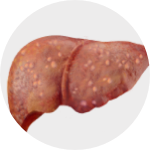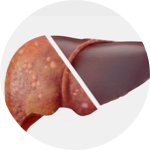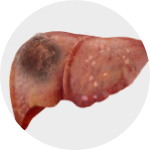NASH with fibrosis—a progressive liver disease with severe consequences1-5
NASH, the most severe form of nonalcoholic fatty liver disease (NAFLD), has a high prevalence that is on the rise6,7
The initial presentation of NASH is heterogeneous9
- Patients may present with:
- Incidental evidence of excessive liver fat10
- Absence of symptoms or mild symptoms (including fatigue, upper right quadrant pain, and epigastric fullness)11
- Severe liver-related conditions10,11
- A normal or near-normal alanine aminotransferase (ALT) or aspartate aminotransferase (AST) level does not exclude NASH; however, many NASH patients are identified once they have an elevated ALT or AST level11
NASH is associated with comorbidities10,12
- Patients with NASH often have other comorbidities, such as:
- Obesity
- Type 2 diabetes
- Dyslipidemia
- Hypertension
- Metabolic syndrome
Take a closer look at NASH pathophysiology in the liver
NASH can drive severe consequences including mortality1-5

NASH can lead to cirrhosis and liver decompensation in many patients.13,14
- ~20% of patients with NASH will develop cirrhosis within ~10 years15
- ~22% of NASH patients with fibrosis stage F3 progress to cirrhosis within 2 years14
- 33% of NASH patients with cirrhosis progress to decompensated liver disease or liver transplant within 4 years16
- The incidence of liver decompensation is estimated to increase by 2.7 times between 2015 and 20307

In the US, NASH is the leading cause for liver transplantation in women and is the second leading cause for all liver transplantation.10,17
- NASH is projected to soon become the leading cause for all liver transplantation10
- NASH is also a leading etiology of liver disease among all candidates for liver transplantation18

It has been estimated that patients with non-cirrhotic NASH have about a 3-fold increased risk of HCC compared to those with liver disease of other etiologies.19
- Projections suggest that the incidence of NASH-associated HCC could more than double between 2015 and 20307

NASH is an independent driver of CVD—even after controlling for confounding factors such as type 2 diabetes, obesity, and smoking.2,4,20
- CVD is the leading cause of mortality in patients with NASH1,4
- Patients with NASH have been shown to be twice as likely to die from CVD as the general population (15.5% vs 7.5% over a mean follow-up period of 13.7 years)21
Managing comorbidities is helpful for overall health, but NASH patients with significant fibrosis require an effective and proven treatment12,22

- Weight loss from lifestyle modifications (ie, diet and exercise) is important for NASH patients with significant fibrosis. Success can be very difficult for the majority of patients22
- For NASH patients with fibrosis, the degree of weight loss required to impact NASH can be challenging to achieve and sustain over time23
- By 2030, estimates project an increase in cases of NASH at every stage of fibrosis, including significant fibrosis7Fibrosis stage F2 or F3 as defined histologically.12,20:
NASH=nonalcoholic steatohepatitis.
Fibrosis stage F2 or F3 as defined histologically.12,24
Discover a management option for your NASH patients
Significant fibrosis is a strong predictor of liver-related mortality in NASH1,25
Stay in touch with NASH
Sign up to receive corporate communications from Madrigal